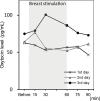Effects of breast stimulation for spontaneous onset of labor on salivary oxytocin levels in low-risk pregnant women: A feasibility study
- PMID: 29447299
- PMCID: PMC5813971
- DOI: 10.1371/journal.pone.0192757
Effects of breast stimulation for spontaneous onset of labor on salivary oxytocin levels in low-risk pregnant women: A feasibility study
Abstract
Objectives: This preliminary study aimed to 1) determine changes in the salivary oxytocin (OT) level during breast stimulation for promoting the spontaneous onset of labor in low-risk term pregnancies, and 2) clarify the feasibility of the breast stimulation intervention protocol in terms of practicality and acceptability.
Methods: We used a single arm trial design. Sixteen low-risk pregnant women between 38 and 40 weeks of gestation with cephalic presentation participated. They performed breast stimulation for 3 days with an attendant midwife in a single maternity hospital. Each breast was stimulated for 15 minutes for a total of 1 hour per day. Saliva was collected 10 minutes before the intervention and 15, 30, 60, 75, and 90 minutes after the intervention, yielding 18 samples per woman.
Results: Among a total of 282 saliva samples from the 16 participants, OT level was measured in 142 samples (missing rate: 49.6%). The median OT level showed the highest values on day 3 of the breast stimulation, with a marked increase 30 min after the intervention. In the mixed models after multiple imputation for missing data, the OT level on the first day of intervention was significantly lower than that on the third day of intervention. Fatigue from breast stimulation decreased on subsequent days, and most of the women (75%) felt no discomfort with the protocol. Uterine hyperstimulation was not observed.
Conclusion: Following a 3-day breast stimulation protocol for spontaneous onset of labor, the mean OT level showed the highest values on day 3. The breast stimulation intervention protocol showed good feasibility in terms of practicality and acceptability among the pregnant women. Additional large-scale studies are warranted to confirm the protocol's effectiveness.
Conflict of interest statement
Figures
Similar articles
-
Oxytocin levels in low-risk primiparas following breast stimulation for spontaneous onset of labor: a quasi-experimental study.BMC Pregnancy Childbirth. 2019 Oct 12;19(1):351. doi: 10.1186/s12884-019-2504-3. BMC Pregnancy Childbirth. 2019. PMID: 31604456 Free PMC article.
-
Changes in salivary oxytocin after inhalation of clary sage essential oil scent in term-pregnant women: a feasibility pilot study.BMC Res Notes. 2017 Dec 8;10(1):717. doi: 10.1186/s13104-017-3053-3. BMC Res Notes. 2017. PMID: 29216912 Free PMC article.
-
A comparison of breast stimulation and intravenous oxytocin for the augmentation of labor.Birth. 1999 Jun;26(2):115-22. doi: 10.1046/j.1523-536x.1999.00115.x. Birth. 1999. PMID: 10687576 Clinical Trial.
-
Novel approach to oxytocin induction-augmentation of labor. Application of oxytocin physiology during pregnancy.Adv Exp Med Biol. 1995;395:585-94. Adv Exp Med Biol. 1995. PMID: 8714022 Review.
-
Oxytocin: behavioral associations and potential as a salivary biomarker.Ann N Y Acad Sci. 2007 Mar;1098:312-22. doi: 10.1196/annals.1384.006. Ann N Y Acad Sci. 2007. PMID: 17435137 Review.
Cited by
-
A longitudinal study of the association of epidural anesthesia and low-dose synthetic oxytocin regimens with breast milk supply and breastfeeding rates.Sci Rep. 2023 Nov 30;13(1):21146. doi: 10.1038/s41598-023-48584-6. Sci Rep. 2023. PMID: 38036700 Free PMC article.
-
Oxytocin levels in low-risk primiparas following breast stimulation for spontaneous onset of labor: a quasi-experimental study.BMC Pregnancy Childbirth. 2019 Oct 12;19(1):351. doi: 10.1186/s12884-019-2504-3. BMC Pregnancy Childbirth. 2019. PMID: 31604456 Free PMC article.
-
Use and Effects of Augmentation of Labor with Oxytocin: A Single-Center, Retrospective, Case-Control Study of 4350 Women in Warsaw, Poland, 2015-2020.Med Sci Monit. 2022 Aug 19;28:e937557. doi: 10.12659/MSM.937557. Med Sci Monit. 2022. PMID: 35982582 Free PMC article.
-
Antenatal breastmilk expression for women with diabetes in pregnancy - a feasibility study.Int Breastfeed J. 2021 Jul 23;16(1):56. doi: 10.1186/s13006-021-00393-1. Int Breastfeed J. 2021. PMID: 34301285 Free PMC article.
References
-
- Gulmezoglu AM, Crowther CA, Middleton P, Heatley E. Induction of labour for improving birth outcomes for women at or beyond term. Cochrane Database Syst Rev. 2012;(6):CD004945 CD004945. doi: 10.1002/14651858.CD004945.pub3 - DOI - PMC - PubMed
-
- Henderson J, Redshaw M. Women's experience of induction of labor: a mixed methods study. Acta Obstet Gynecol Scand. 2013;92: 1159–1167. doi: 10.1111/aogs.12211 - DOI - PubMed
-
- Waldenstrom U, Hildingsson I, Rubertsson C, Radestad I. A negative birth experience: prevalence and risk factors in a national sample. Birth. 2004;31: 17–27. - PubMed
-
- Gregory SG, Anthopolos R, Osgood CE, Grotegut CA, Miranda ML. Association of autism with induced or augmented childbirth in North Carolina Birth Record (1990–1998) and Education Research (1997–2007) databases. JAMA Pediatr. 2013;167: 959–966. doi: 10.1001/jamapediatrics.2013.2904 - DOI - PubMed
-
- Oberg AS, D'Onofrio BM, Rickert ME, Hernandez-Diaz S, Ecker JL, Almqvist C, et al. Association of labor induction with offspring risk of autism spectrum disorders. JAMA Pediatr. 2016;170: e160965 doi: 10.1001/jamapediatrics.2016.0965 - DOI - PMC - PubMed
Publication types
MeSH terms
Substances
LinkOut - more resources
Full Text Sources
Other Literature Sources
Medical





